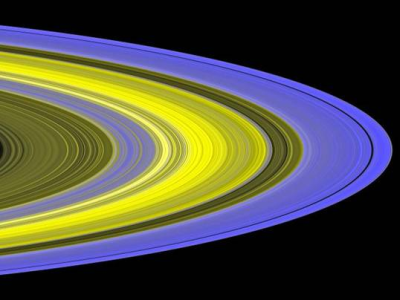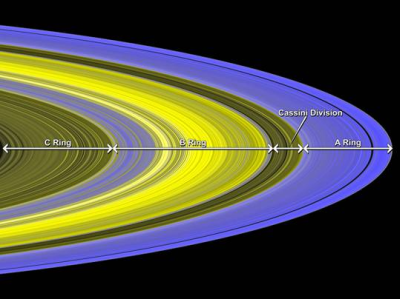28 May 2007

Credit: NASA/JPL/University of Colorado
Recent data from the Cassini spacecraft show that the B ring, Saturn's largest and densest ring is composed of tightly packed clumps of particles separated by nearly empty gaps.
It was very surprising to scientists that these clumps are neatly organized and continuously colliding.
"The rings are different from the picture we had in our minds. We originally thought we would see a uniform cloud of particles. Instead we find that the particles are clumped together with empty spaces in-between," said Larry Esposito, Principal Investigator for the Cassini Ultraviolet Imaging Spectrograph.
"If you were flying under Saturn's rings in an airplane, you would see these flashes of sunlight come through the gaps, followed by dark and so forth. This is different from flying under a uniform cloud of particles."
As the ring particles were interpreted to be uniformly distributed, scientists underestimated the total mass of Saturn's rings. The actual mass may be at least two times larger than previous estimates.
"These results will help us understand the overall question of the age and hence the origin of Saturn's rings," said Josh Colwell, a team member of the Cassini Ultraviolet Imaging Spectrograph.
Recently, the rings occulted a star on several occasions. Scientists observed the brightness of the star as it shone through the rings. This provided a measurement of the amount of ring material between the spacecraft and the star.
Colwell explained that analyzing the data of such occultation events is like doing a CAT scan of the rings. Therefore, by studying the brightness of stars as the rings pass in front of them, the ring structure in 3-D can be mapped, and information about the shape, spacing and orientation of swarms of particles can be inferred.
The observations confirm that due to their gravitational attraction, the ring particles aggregate to form the clumps, or "self-gravity wakes." If the clumps were farther from Saturn, they might continue to accumulate forming a moon. As these clumps are so close to Saturn, their various speeds around Saturn oppose this gravitational attraction in a manner that leads to the stretching of clumps. They are likened to taffy.

Annotated picture of Saturn's rings
Credit: NASA/JPL/University of Colorado
The clumps are constantly forming and coming apart once they are 30 m to 50 m across. Scientists are also surprised that the B ring clumps are flatter and more closely spaced than those found in the neighboring A ring.
A picture of the rings based on these results is available at the following websites.
http://www.nasa.gov/cassini
http://saturn.jpl.nasa.gov
http://lasp.colorado.edu/cassini/whats_new/
Further Reading
The shadows of Saturn's rings
http://www.bibalex.org/eclipse2006/News_Details.aspx?id=214
Aymen Mohamed Ibrahem
Senior Astronomy Specialist